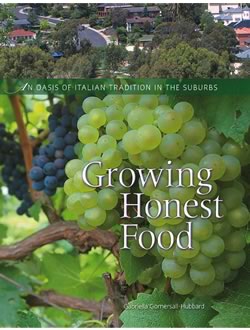 Review by Gail Thomas
Review by Gail Thomas
Eager to keep their Italian traditions alive after coming to Australia in 1965 Lina and Tony Siciliano started a new life together in suburban Essendon. With only a small garden they yearned to grow their own food so in 1981 acquired a barren block of land in East Keilor where they planted fruit trees and vegetables and raised chickens. Thirty years on and the couple have transformed the site into a profitable business boasting a productive bounty of 400 olive trees, an orchard, vegetable garden and their Rose Creek Estate vineyard.
Taking a month by month approach author Gabriella Gomersall-Hubbard has documented the family’s sustainable way of life from preserving – think big tomato day and sausage making – to producing olive oil and wine. Colour photos throughout capture the essence of the Siciliano’s seasonal activities in the garden and kitchen while traditional recipes reinforce that achievable goal of growing organically, knowing where your food comes from and ensuring low food miles. Try a spicy pasta with potatoes and cavolo nero or the slow cooked capretto with fresh peas.
Review by Penny Woodward
This lovely book is full of delights. For those of us lucky enough to have visited Rose Creek Estate, to have met Tony and Lina, and eaten their food, this book is a wonderful evocation of their lives and lifestyle. Read more
Article and photos by Gail Thomas
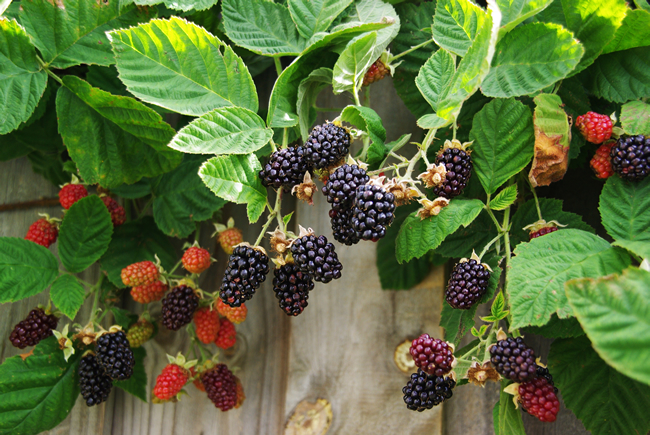 Marionberries are one of the most luscious summer fruits, and although the plants are thorny the resulting delicious fruit far outweighs any prickly encounters! A cross between the Chehalem and Olallieberry blackberries, this vigorous trailing cane blackberry cultivar is named after the county of Marion Oregon where they were developed in the 1950’s. Read more
Marionberries are one of the most luscious summer fruits, and although the plants are thorny the resulting delicious fruit far outweighs any prickly encounters! A cross between the Chehalem and Olallieberry blackberries, this vigorous trailing cane blackberry cultivar is named after the county of Marion Oregon where they were developed in the 1950’s. Read more
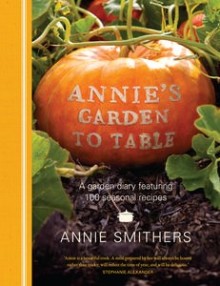 A garden diary featuring 100 seasonal recipes
A garden diary featuring 100 seasonal recipes
I felt a real affinity for this book from the very first pages. I love the way Annie admits her mistakes and uses them to learn for the following years. Very much a cook first and a gardener second, as Annie says ‘It became obvious within minutes of discussing the way forward that anything I thought I knew about gardening was not going to be very useful and this was an opportunity for me to learn not to instruct or dictate.’ And this is what she does. With the help of Simon Rickard, ‘a meticulous plants man with a huge interest in heirloom and old varieties of fruit and vegetables’, Annie established extensive vegetable beds and plantings of fruit trees. It is this fascinating story, combined with the seasonal recipes that make this book special. Annie reminds us that simple foods rely on the quality of the ingredients, and the very best ingredients come from our own gardens, freshly picked. This book is for anyone who grows their own vegies and fruit. It helps you to realise that things do go wrong, but often enough they also go right and that there is real joy in harvesting our freshly grown produce and then cooking them in simple but delicious ways. If you don’t grow your own, but buy from markets or local green grocers, you will enjoy the tales of the vicissitudes of gardening life, and delight in the recipes. Annie finishes the book by saying ‘We should all make the time to grow a piece of food, if only to fully appreciate how hard it can be. This in turn will give us a healthier understanding of the value of good food and its absolute preciousness as a resource.’ With beautiful pictures by Simon Griffiths, this is another book to add to my shelf for constant reference. Borrow it from your library or buy from your local independent bookshop.
Annie Smithers, 256 pages, HB, ISBN-13:9781921382345, Lantern (Penguin), $49.95
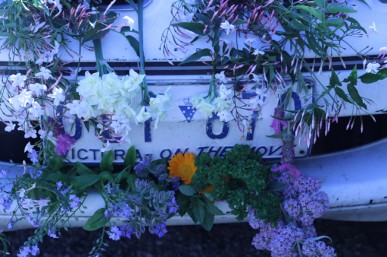 Like so many gardeners in this beautiful state I think we should be on the move to again declare ourselves The Garden State. It is time we repossessed the logo and put it back on our number plates. As Glenn Fenton, President of Nursery & Garden Industry Victoria says “Victoria is home to some of the most beautiful and historic gardens in the country, and there is no better time of year than Spring to remind us how important those gardens are to the character and identity of our State”. In his article in the Sunday Age yesterday, award winning landscape gardener Jim Fogarty reminded us that “Greening cities is now a significant driver of investment” and that “Greening cities brings significant benefits to our physical and metal health”. When you add to this the plethora of gardens, including more than 100 community gardens, 32 botanic gardens, important avenues of street trees and the tens of thousands of back yards and balconies where families grow their own food then it would be hard to find a better brand for our state. If you want to support this move then go to this facebook page
Like so many gardeners in this beautiful state I think we should be on the move to again declare ourselves The Garden State. It is time we repossessed the logo and put it back on our number plates. As Glenn Fenton, President of Nursery & Garden Industry Victoria says “Victoria is home to some of the most beautiful and historic gardens in the country, and there is no better time of year than Spring to remind us how important those gardens are to the character and identity of our State”. In his article in the Sunday Age yesterday, award winning landscape gardener Jim Fogarty reminded us that “Greening cities is now a significant driver of investment” and that “Greening cities brings significant benefits to our physical and metal health”. When you add to this the plethora of gardens, including more than 100 community gardens, 32 botanic gardens, important avenues of street trees and the tens of thousands of back yards and balconies where families grow their own food then it would be hard to find a better brand for our state. If you want to support this move then go to this facebook page
to register. And don’t forget to spread the word to your friends.
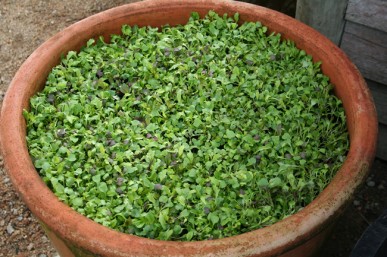 According to recent research (see below) and reported on Science Daily microgreens are higher in a range of nutrients than their more adult forms. My favourite microgreens are young leafy salad plants like lettuce, spinach, mizuna, and rocket, but red cabbage, bok choy, kale and mustard are also delicious. Throw in a few garlic chive or onion seeds to add piquancy, as well basil or dill and you will have a truly multicultural mix. Microgreens are sown into soil (I use potting mix) in seed trays or pots. Keep them just moist in a sunny position and two to three weeks later they are ready to harvest. Just cut them with scissors, add to salad, use as a garnish or sprinkle over a sandwich. Not only do they taste great but research has shown that healthy vitamins and carotenoids are found in larger amounts than their mature counterparts. For example, red cabbage microgreens are high in vitamin C, while green daikon radish microgreens were rich in vitamin E. Anyone with a sunny windowsill can grow microgreens, so why not buy some seed (both Diggers and Green Harvest sell seed), alternatively it is a great way to use up your old packets of herb and vegetable seed.
According to recent research (see below) and reported on Science Daily microgreens are higher in a range of nutrients than their more adult forms. My favourite microgreens are young leafy salad plants like lettuce, spinach, mizuna, and rocket, but red cabbage, bok choy, kale and mustard are also delicious. Throw in a few garlic chive or onion seeds to add piquancy, as well basil or dill and you will have a truly multicultural mix. Microgreens are sown into soil (I use potting mix) in seed trays or pots. Keep them just moist in a sunny position and two to three weeks later they are ready to harvest. Just cut them with scissors, add to salad, use as a garnish or sprinkle over a sandwich. Not only do they taste great but research has shown that healthy vitamins and carotenoids are found in larger amounts than their mature counterparts. For example, red cabbage microgreens are high in vitamin C, while green daikon radish microgreens were rich in vitamin E. Anyone with a sunny windowsill can grow microgreens, so why not buy some seed (both Diggers and Green Harvest sell seed), alternatively it is a great way to use up your old packets of herb and vegetable seed.
(Zhenlei Xiao, Gene E. Lester, Yaguang Luo, Qin Wang. Assessment of Vitamin and Carotenoid Concentrations of Emerging Food Products: Edible Microgreens. Journal of Agricultural and Food Chemistry, 2012; 60 (31): 7644 DOI: 10.1021/jf300459b)
Review by Gail Thomas
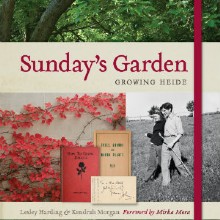 The Heide Museum of Modern Art at Bulleen in Victoria was a neglected former dairy farm when Sunday and John Reed purchased the property in 1934. At the end of their lives and after fifty years of dedication Heide was rich with exotic and native flora and boasted a stunning cottage-style kitchen garden.
The Heide Museum of Modern Art at Bulleen in Victoria was a neglected former dairy farm when Sunday and John Reed purchased the property in 1934. At the end of their lives and after fifty years of dedication Heide was rich with exotic and native flora and boasted a stunning cottage-style kitchen garden.
As art benefactors the Reeds also created a nourishing environment for the artists they championed including Sidney Nolan, Albert Tucker, Joy Hester, Charles Blackman and Mirka Mora some of whose artworks are dotted throughout the book together with historic photos and more recent garden images. Nolan’s poems to Sunday and a dramatis personae of those who contributed to Heide’s rich tapestry and history all add to this fascinating read while a timeline from the 1800’s through to present day documents the couple’s lives, work and garden plantings on the property.
In the 1960’s Sunday’s love of roses is reflected in her rose planting list – Heide’s most famous rose Mutabilis was immortalized in Sidney Nolan’s 1945 painting – Sunday and Susie Bruntion set up Heide Herbs selling herbs propagated in the Heide I kitchen garden and there’s the construction of Heide II, a modernist home on the property which was sold to the Victorian Government in 1980 while the following year Heide Park and Art Gallery is opened.
A comprehensive glossary of trees and plants has been compiled by Heide’s current head gardener Dugold Noyes, in recent times the Heide II kitchen garden and rose walk have been restored and the wild garden is the focus of a major restoration project.
This captivating book will appeal to both art and garden lovers as it explores this intriguing property and its creators.
by Lesley Harding and Kendrah Morgan Miegunyah RRP: $45.00
by Ross McKenzie
Review by Gail Thomas
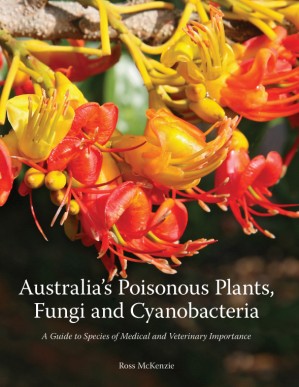 This impressive 976 page tome written in a straight forward accessible format is an invaluable tool for a wide range of people from farmers and graziers, horticulturalists and natural resource managers to landscape architects, agricultural advisers and consultants, veterinarians and horse owners as well as poisons information centres, hospital emergency departments and medical practitioners.
This impressive 976 page tome written in a straight forward accessible format is an invaluable tool for a wide range of people from farmers and graziers, horticulturalists and natural resource managers to landscape architects, agricultural advisers and consultants, veterinarians and horse owners as well as poisons information centres, hospital emergency departments and medical practitioners.
Diligently researched and written by Ross McKenzie, retired veterinary pathologist, toxicologist and research scientist from the Queensland Department of Primary Industries where he diagnosed and researched diseases of livestock for 36 years (1973-2009).
Ross has been honoured with numerous awards throughout his career, has authored over 100 scientific publications, has contributed to several international veterinary text and reference books and is now an Honorary Research Associate of Queensland Herbarium and of Biosecurity Queensland.
Australia’s Poisonous Plants, Fungi and Cyanobacteria is the first full-colour comprehensive guide to the major natural threats to health in Australia affecting domestic and native animals and humans – the overriding aim of the book is to prevent poisoning as there are few effective treatments available, particularly in domestic animals. Read more







